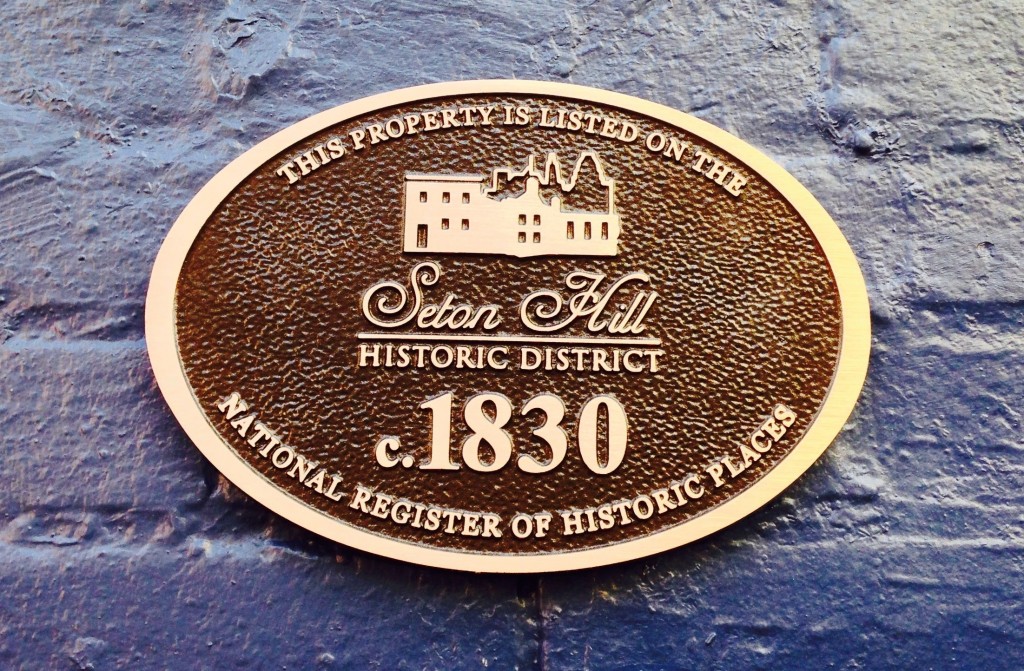
Who hasn’t wanted to know more about their property? If you’re interested in researching the history of a property in Seton Hill, looking at the land records is a great place to start! Seton Hill was added to the National Register for Historic Places in 1975, making it one of the first historic districts in Baltimore.
Follow this link for some tips from the professionals at Baltimore Heritage, or follow the directions below.
- Go to MDLandRec.net, sign up and get your password (it’s free).
- At the top of the page there is a drop down list that says “Select County”, Select Baltimore City (If you are searching for a record before 1850 or so, you may need to select Baltimore County. The border of the City was Franklin Street before 1850).
- On the left hand side click “Address”. I am using 404 George Street as a sample.
- Enter the address. Please note do not use direction (North, South, East, West) or street type (Street, Avenue, Road, Alley, etc). Click Search
- You will get a list of deed transfer, ground leases, etc. If you want the full record, start with the most recent date, if you want to determine the build date, search for the oldest. For 404 George Street there are 5 records from November 21, 1978. They all reference the same book and subsequent pages, so this is the record we are looking for. Click on one of the links for that book.
- A scanned copy in PDF form of this record comes up on the left. On the right are navigation buttons. At the bottom of the first page is a description of 404 George Street. At the end of the description is the following: “BEING part of the property which by Deed of Assignment dated June 16, 1972, and recorded among the Land Records of Baltimore City in Liber RHB No. 2921, folio 314…” This is the information you are looking for. “Liber (or Libre)” means book, “Folio” means page.
- Click “Search” at the top of the page.
- Enter the new Liber and Folio numbers you found in the appropriate field. As the same “Book” number is used multiple times in the last 200 years, you will get a list of several Libers with the Folio number. In our example there are four. Click the one that corresponds to the year that you are looking for, in this case 1972.
- Look through the new record for the Liber and Folio number. In the example the new reference is November 24, 1952, Liber 8997 Folio 244. Additionally the example is not just for 404, but also for 406 and 408. These houses were sold as a set. Please keep this in mind as you go further back in the history of the deed. The remaining deed transfers for this house are:
- July 9, 1914 L2913 F125 (First hand written record & first record to use only the old name “New Street”)
- May 13, 1909 L2499 F428
- July 21, 1860 L196 F336 (This copy is almost impossible to read. But you can look up the last name of the parties, in this case Henry Kaiser Jr. in the Indices section. Look for the year 1858 and the last name)
- June 17, 1858 L149 F420
- May 13, 1839 L289 F264 (This is the first one in Baltimore County. George Street is now called “New Lane”)
- September 8,1825 L179 F547
- June 24, 1815 L131 F393
- July 3, 1802 L73 F154 (This, the oldest record, the ground rent is listed in shillings). Here it is!
- Once you get to the oldest record, you are done with the deed search. These are property records, not building records, so some assumptions will need to be made, or further research will have to be conducted to get to build dates. Volunteers with the Seton Hill Association may be able to assist you in determining the build date on your house. Either save copies of the deed, or provide the neighborhood association volunteers with all book and page references.
Some extra tips:
- Choosing Baltimore County vs Baltimore City. When I researched my house, I was able to trace it back to its probable build date after trying the Baltimore County records. When the City borders were extended north of Franklin, Seton Hill was then in the City vs the County.
Sometimes you get a wrong page number, and as these volumes are 1500 or more pages long, it can be daunting to track it down. But, they all have indexes at or before page 1. These are semi-alphabetical by last name, so if you know that Mr Green sold a house to Mr Smith in 1908 and the book referenced is in 1890, but the page number is wrong, i.e. the page doesn’t contain any reference to the property you are looking for, then go to the index and look for Mr Green, and you will get the right page. Page numbers are either transposed (561 instead of 516), digit missing (56 instead of 516), bad penmanship (576 instead of 516), or lazy (123 instead of 516). - Sometimes you will get a wrong book number. There are also volumes of indices by last name and year.
- The Seton Hill Historic District nomination has some helpful information on the history of our buildings.
- Drawn maps of Baltimore showing developed streets (zoom in to see Seton Hill):
- From the archives of the Sulpicians of the United States at Saint Mary’s Seminary, maps of Seton Hill showing subdivided lots around the Seminary complex in 1856:
- Some helpful links from Baltimore Heritage:
- Chain of Title Research: http://baltimoreheritage.org/resources/how-to-research-the-chain-of-title-for-your-historic-property/
- Local History Resource Links: http://baltimoreheritage.org/resources/digital-sources-for-local-history-research/